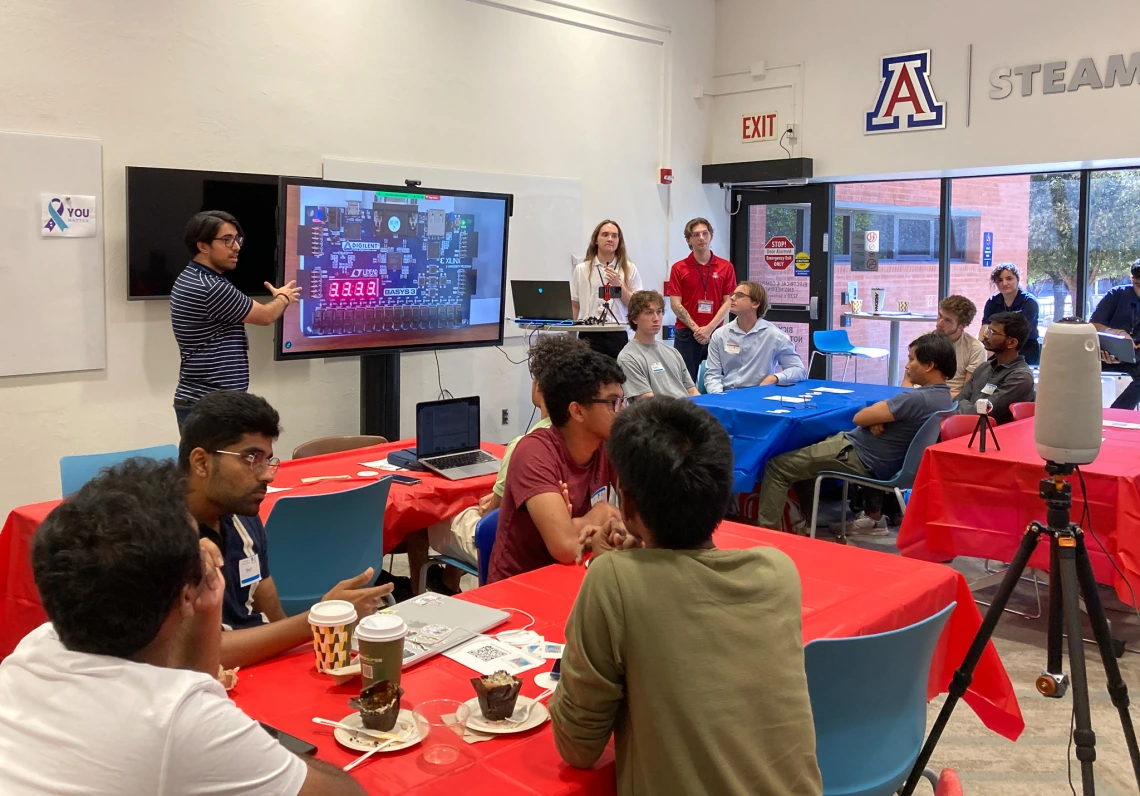CSM Kicks Off AI Hardware Design League for Students to Explore Semiconductor Manufacturing Career Opportunities

As Arizona looks to help boost the national semiconductor manufacturing industry, the university has launched the Artificial Intelligence Hardware Design League, a competition for students to gain hands-on learning experiences in semiconductor design using AI tools – no experience required!
The four-phase AI-HDL competition kicked off on October 25, with 200 registered undergrad and graduate student participants from U of A and community college and international university partners: Pima Community College, Pasadena City College, VNU University of Engineering and Technology, Hanoi University of Science and Technology, University of New South Wales, Heidelberg University, and Digital University Kerala.
Semiconductor chip designers are in demand
During the hybrid in-person and Zoom kickoff event, students received an overview of hardware design and security and learned about the major demand for chip designers and manufacturing engineers. The participants also received an overview of the league’s design challenge and timeline as well as an introduction to the tools they will be using throughout the competition such as ChatGPT, Verilog (a language for describing hardware), and Vivado (a software suite for designing, simulating, and programming digital circuits).
Dr. Liesl Folks, director of the University of Arizona Center for Semiconductor Manufacturing, emphasized the importance of microelectronics and the growth of the field.
“Semiconductors are everywhere in our daily lives-smartphones, laptops, tablets. The biggest potential outcome of being part of AI-HDL is that you will understand how these technologies are brought to market and that will inform all of your future career opportunities. It will be a stepping stone in your career no matter where you're headed.”
Getting students excited about chip design
AI-HDL participants compete in teams of three to five members. Each team will design a digital watch using AI tools, including ChatGPT, to assist with Verilog code generation. During each design phase, teams will gradually implement more advanced features to their designs. Final designs will be evaluated by mentors, faculty partners, and industry sponsors. Competition sponsor Efabless Corporation, which manufactures custom chips, will “tapeout” and fabricate the winning designs. The winners will be announced at the end of February.
AI-HDL founder and lead Dr. Soheil Salehi, assistant professor of electrical and computer engineering, says powerful AI tools can help students get started in chip design without having a background in engineering. He added, “The goal is to give students the opportunity to gain hands-on experiences in semiconductor hardware design, using AI tools to simplify traditionally complex tasks in the design process.”
Dr. Salehi was inspired to establish AI-HDL to get students, regardless of academic background or experience, excited about semiconductor chip design and encourage them to pursue career opportunities in the fast-growing semiconductor field. “Students will be able to start by prompting large language models, like ChatGPT, tweak the responses a little bit, and then get to a functional design,” he said.
Learning through industry and peer mentorship
Kudzai Musarandega, an international student from Zimbabwe studying applied physics, says she is always on the lookout for new opportunities to challenge herself and to network with peers and faculty.
“[AI-HDL] is a very interesting and more engaging way to learn things. You really get to push yourself,” Musarandega said.
She also emphasized the importance of learning how to utilize AI tools. “There's no going back to a time where AI is not part of our lives,” she said.
League participants have access to mentorship from industry leaders from Arm Semiconductor Company. Additionally, peer mentors will help build a solid foundation of knowledge in-demand skills for the high-growth, high-impact semiconductor sector.
“Peer learning, I think, is a powerful tool. The AI-HDL structure allows students to ask questions and learn together while working as a group, and troubleshoot their designs with mentors,” Dr. Salehi said.
Mentors are available each week to assist participants in the competition. Jaeden Carpenter, a U of A graduate student studying electrical and computer engineering, is an AI-HDL mentor. Carpenter is looking forward to seeing his mentees progress through the league.
“I want to see what it's like from the first week until the last week, how they go about learning the material,” Carpenter said.
Mohit Rakesh Taparia, a U of A graduate student from India studying data science, is excited to gain hands-on experience in semiconductor hardware design.
“I would love to win this competition and to see my [chip fabricated],” Rakesh Taparia said.
AI-HDL is sponsored by the University of Arizona Center for Semiconductor Manufacturing, Institute for Computation & Data-Enabled Insight and Department of Electrical & Computer Engineering, and industry leaders Arm and Efabless Corporation.
